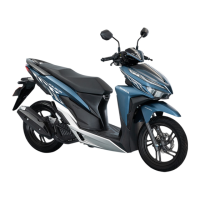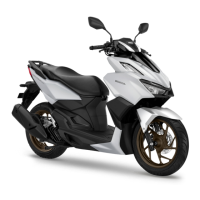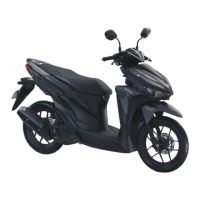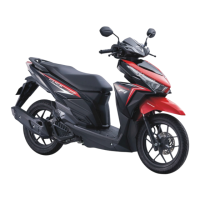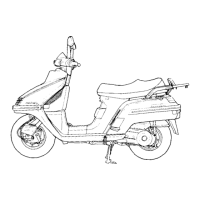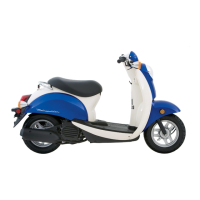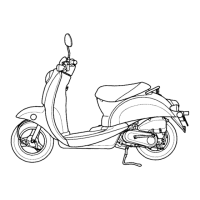Do you have a question about the Honda Click125i 2022 and is the answer not in the manual?
Identifies country-specific codes for scooter models.
Provides essential tips for enhancing rider safety.
Outlines critical precautions for safe operation and passenger handling.
Emphasizes the importance of helmets and protective apparel.
Advises vigilance and attentiveness to other vehicles.
Warns against the dangers of combining alcohol and riding.
Highlights the importance of regular maintenance for safety.
Explains the dangers of carbon monoxide from exhaust gases.
Details essential protective gear like helmet, gloves, boots, and clothing.
Guidelines for the first 500 km to ensure scooter reliability.
Advises on proper braking techniques and precautions.
Specific safety measures for riding in wet weather.
Instructions for parking the scooter securely on various surfaces.
Information on using the correct fuel and refueling procedures.
Steps for a thorough inspection before riding the scooter.
Procedure for starting the scooter's engine.
How to apply front and rear brakes effectively for stopping.
Techniques for braking before and accelerating out of corners.
Explains the function of the speedometer and its units.
Details on the fuel gauge indicator and its low fuel warning.
Explains the functions of the odometer, tripmeter, fuel mileage, and battery voltage meters.
Describes the function of the oil change reminder and how to reset it.
Details how to change settings like clock and oil change indicator.
Step-by-step guide for setting the digital clock on the instrument panel.
Meaning and action required if the PGM-FI indicator light comes on.
Describes the indicator for the Idling Stop System.
Indicates the battery charging status warning light.
Operation of the switch to control the Idling Stop System.
Controls the electrical system, steering lock, and seat opener.
How to lock and unlock the scooter's steering for security.
Steps to activate and set the anti-theft alarm.
Procedures for disarming or cancelling the anti-theft alarm.
Step-by-step guide for replacing the battery in the remote transmitter.
How to engage the rear brake lock mechanism.
How to enable or disable the Idling Stop System.
Conditions required for the Idling Stop System to become active.
Procedures for restarting the engine after it has stopped via the system.
Troubleshooting for when the engine won't start with the throttle open.
Proper technique for accelerating and decelerating using the throttle.
Troubleshooting steps if the engine fails to start.
Comprehensive guide to safely starting and moving the scooter.
Step-by-step guide to opening the fuel tank cap.
Instructions for properly closing the fuel tank cap.
How to open the scooter's seat compartment.
Location and use of helmet holders under the seat.
Information on the luggage box capacity and restrictions.
Lists the tools provided and their usage for minor repairs.
Location and load capacity of the glove box.
Safety guidelines and precautions to follow during maintenance tasks.
Detailed checklist for pre-ride checks of essential scooter components.
Information on the maintenance-free battery and its care.
Guidance on cleaning the crankcase breather tube.
Emergency procedures for electrolyte splashes into eyes, skin, or mouth.
Procedure for inspecting and replacing blown fuses.
Guidelines for choosing the correct engine oil based on standards.
Recommendations and precautions for brake fluid.
Details on the recommended coolant and its properties.
Procedures for inspecting tyre condition, air pressure, and wear.
How to check tyre tread depth using wear indicators.
Step-by-step guide for removing and installing the scooter battery.
Procedure for inspecting, cleaning, and gapping the spark plug.
How to check the engine oil level using the dipstick.
Guide for changing engine oil and cleaning the oil strainer screen.
How to check the coolant level in the reserve tank.
Procedures for adding coolant to the reserve tank.
How to check the brake fluid level and condition.
How to measure and check the freeplay of the rear brake lever.
Steps for adjusting the freeplay of the rear brake lever.
How to check the rear brake shoes for wear using an indicator.
Procedures for checking the side stand's operation and safety function.
How to check throttle operation, smoothness, and freeplay.
Instructions for cleaning the crankcase breather tube.
Guide on adjusting the vertical aim of the headlights.
Step-by-step guide for replacing the battery in the remote transmitter.
Troubleshooting steps when the starter motor works but the engine doesn't start.
Troubleshooting steps when the starter motor does not operate at all.
Meaning and action required if the PGM-FI indicator light comes on.
Indicates the battery charging status warning light.
How to identify and what to do if the fuel gauge shows an error.
Steps to troubleshoot why the Idling Stop indicator is not active.
How low battery voltage can affect the Idling Stop System.
Guide on performing an emergency tire repair with a kit.
Steps for charging a dead battery and precautions.
Information on LED lights and when to seek servicing for non-functional ones.
Information on scooter lights and troubleshooting non-working LEDs.
Information on rear lights and troubleshooting non-working LEDs.
How to identify and replace blown fuses in the fuse box.
Location and identification of the main and spare fuses.
Importance of recording key numbers and storing spare keys.
Care and handling instructions for the remote transmitter.
Usage of the ignition switch and warnings about battery drain.
Information on the odometer's maximum reading and display behavior.
Guidelines for washing the scooter to maintain its condition.
Precautions to avoid damage during washing, like using high-pressure water.
Guidelines for storing the scooter for extended periods.
Proper methods for transporting the scooter safely.
Advice on using environmentally friendly cleaning products.
Lists key physical and performance specifications of the scooter.
Provides detailed technical data for tires, spark plugs, fluids, and engine oil.
Specifies torque values for critical fasteners like drain and oil plugs.
Identifies country-specific codes for scooter models.
Provides essential tips for enhancing rider safety.
Outlines critical precautions for safe operation and passenger handling.
Emphasizes the importance of helmets and protective apparel.
Advises vigilance and attentiveness to other vehicles.
Warns against the dangers of combining alcohol and riding.
Highlights the importance of regular maintenance for safety.
Explains the dangers of carbon monoxide from exhaust gases.
Details essential protective gear like helmet, gloves, boots, and clothing.
Guidelines for the first 500 km to ensure scooter reliability.
Advises on proper braking techniques and precautions.
Specific safety measures for riding in wet weather.
Instructions for parking the scooter securely on various surfaces.
Information on using the correct fuel and refueling procedures.
Steps for a thorough inspection before riding the scooter.
Procedure for starting the scooter's engine.
How to apply front and rear brakes effectively for stopping.
Techniques for braking before and accelerating out of corners.
Explains the function of the speedometer and its units.
Details on the fuel gauge indicator and its low fuel warning.
Explains the functions of the odometer, tripmeter, fuel mileage, and battery voltage meters.
Describes the function of the oil change reminder and how to reset it.
Details how to change settings like clock and oil change indicator.
Step-by-step guide for setting the digital clock on the instrument panel.
Meaning and action required if the PGM-FI indicator light comes on.
Describes the indicator for the Idling Stop System.
Indicates the battery charging status warning light.
Operation of the switch to control the Idling Stop System.
Controls the electrical system, steering lock, and seat opener.
How to lock and unlock the scooter's steering for security.
Steps to activate and set the anti-theft alarm.
Procedures for disarming or cancelling the anti-theft alarm.
Step-by-step guide for replacing the battery in the remote transmitter.
How to engage the rear brake lock mechanism.
How to enable or disable the Idling Stop System.
Conditions required for the Idling Stop System to become active.
Procedures for restarting the engine after it has stopped via the system.
Troubleshooting for when the engine won't start with the throttle open.
Proper technique for accelerating and decelerating using the throttle.
Troubleshooting steps if the engine fails to start.
Comprehensive guide to safely starting and moving the scooter.
Step-by-step guide to opening the fuel tank cap.
Instructions for properly closing the fuel tank cap.
How to open the scooter's seat compartment.
Location and use of helmet holders under the seat.
Information on the luggage box capacity and restrictions.
Lists the tools provided and their usage for minor repairs.
Location and load capacity of the glove box.
Safety guidelines and precautions to follow during maintenance tasks.
Detailed checklist for pre-ride checks of essential scooter components.
Information on the maintenance-free battery and its care.
Guidance on cleaning the crankcase breather tube.
Emergency procedures for electrolyte splashes into eyes, skin, or mouth.
Procedure for inspecting and replacing blown fuses.
Guidelines for choosing the correct engine oil based on standards.
Recommendations and precautions for brake fluid.
Details on the recommended coolant and its properties.
Procedures for inspecting tyre condition, air pressure, and wear.
How to check tyre tread depth using wear indicators.
Step-by-step guide for removing and installing the scooter battery.
Procedure for inspecting, cleaning, and gapping the spark plug.
How to check the engine oil level using the dipstick.
Guide for changing engine oil and cleaning the oil strainer screen.
How to check the coolant level in the reserve tank.
Procedures for adding coolant to the reserve tank.
How to check the brake fluid level and condition.
How to measure and check the freeplay of the rear brake lever.
Steps for adjusting the freeplay of the rear brake lever.
How to check the rear brake shoes for wear using an indicator.
Procedures for checking the side stand's operation and safety function.
How to check throttle operation, smoothness, and freeplay.
Instructions for cleaning the crankcase breather tube.
Guide on adjusting the vertical aim of the headlights.
Step-by-step guide for replacing the battery in the remote transmitter.
Troubleshooting steps when the starter motor works but the engine doesn't start.
Troubleshooting steps when the starter motor does not operate at all.
Meaning and action required if the PGM-FI indicator light comes on.
Indicates the battery charging status warning light.
How to identify and what to do if the fuel gauge shows an error.
Steps to troubleshoot why the Idling Stop indicator is not active.
How low battery voltage can affect the Idling Stop System.
Guide on performing an emergency tire repair with a kit.
Steps for charging a dead battery and precautions.
Information on LED lights and when to seek servicing for non-functional ones.
Information on scooter lights and troubleshooting non-working LEDs.
Information on rear lights and troubleshooting non-working LEDs.
How to identify and replace blown fuses in the fuse box.
Location and identification of the main and spare fuses.
Importance of recording key numbers and storing spare keys.
Care and handling instructions for the remote transmitter.
Usage of the ignition switch and warnings about battery drain.
Information on the odometer's maximum reading and display behavior.
Guidelines for washing the scooter to maintain its condition.
Precautions to avoid damage during washing, like using high-pressure water.
Guidelines for storing the scooter for extended periods.
Proper methods for transporting the scooter safely.
Advice on using environmentally friendly cleaning products.
Lists key physical and performance specifications of the scooter.
Provides detailed technical data for tires, spark plugs, fluids, and engine oil.
Specifies torque values for critical fasteners like drain and oil plugs.
| Displacement | 124.9 cc |
|---|---|
| Bore x Stroke | 52.4 x 57.9 mm |
| Compression Ratio | 11.0:1 |
| Max Torque | 10.8 Nm @ 5, 000 rpm |
| Fuel System | PGM-FI (Programmed Fuel Injection) |
| Frame Type | Underbone |
| Front Suspension | Telescopic Fork |
| Rear Suspension | Unit Swing |
| Front Brake | Disc |
| Rear Brake | Drum |
| Wheelbase | 1, 280 mm |
| Seat Height | 769 mm |
| Ground Clearance | 132 mm |
| Curb Weight | 111 kg |
| Max Power | 8.3 kW (11.1 hp) @ 8, 500 rpm |
| Ignition System | Full transistorized |
| Starting System | Electric |
| Transmission | V-Matic |
| Fuel Tank Capacity | 5.5 L |
| Engine Type | Single-cylinder, 4-stroke, SOHC |
| Front Tire | 80/90-14 |
| Rear Tire | 90/90-14 |



